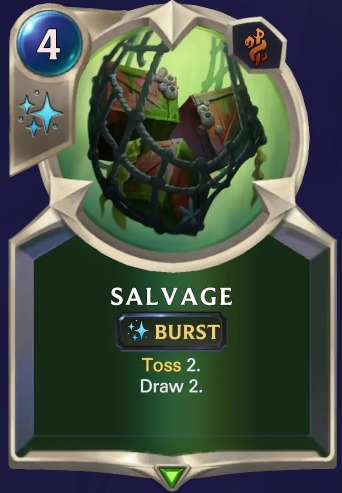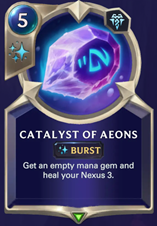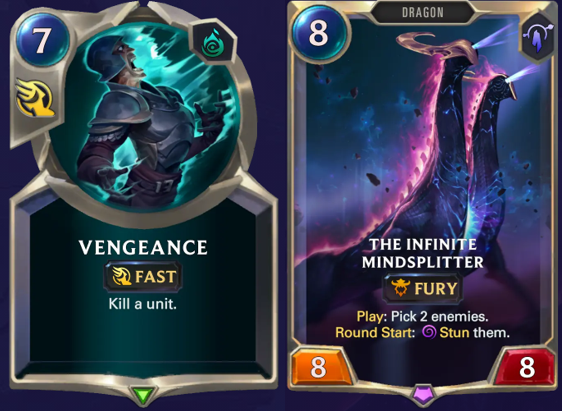Card Game Concepts: Tempo, what it is and how to use it
Let’s start our dive into the basics of card games. Our first stop will be analysing Tempo in Legends of Runeterra.
Let’s start our dive into the basics of card games. Our first stop will be analysing Tempo in Legends of Runeterra.
While specific strategies and mechanics vary from card game to card game, some remain equally important. Those fundamental concepts will be the focus of this series of articles, and learning or expanding on them even if you are already familiar will greatly increase the quality of your gameplay and awareness. Today we will focus on the concept of “Tempo”.
But first, what is tempo exactly? It can have various definitions, but the simplest one to understand is “board presence” and the pressure that derives from that. Tempo in fact is used to describe how the rhythm of the match unfolds for both players, and it articulates the pace of their fight.
As a resource, tempo is strictly connected with your mana and your health points, but it can also be tied with card advantages. As an example we can think about a Deep deck using all his mana on turn 3 or 4 to play Salvage. At the end of the turn he will have gained a card advantage in hand (cycling the spell and drawing 1 more card), but he will have lost some pressure on board with a subsequent Tempo loss.
Now, it's very important to be able to choose when losing tempo is the right play, and whether our deck's playstyle relates to it, so remember that in a vacuum there are no right and wrong answers, because most of decks have different mulligans and slightly different curves based on matchups.

Using mana efficiently: the mana curve
After talking about the raw definition, let's think how to utilize it in an actual match.
The most common way is playing alongside the mana curve: from turn 0 to 10, your deck might be built to perfectly fit into the flow of the game so you can always have something to play to apply pressure and never waste mana, which for example is a classic Demacian gameplay.
On most card games it's that simple, but Legends of Runeterra has something that others have not: the opportunity to bank up to three spell mana. That single difference has made it possible for many archetypes to rely much more on spells than units to influence the state of the game, so evaluating Tempo gains and losses is not easy.
There are also strategies that focus on speeding up your mana curve faster than normal using “ramp” spells and units like Catalyst of Aeons. In that way, you can gain access to much stronger units and spells, cheating your mana gems and overwhelming Tempo advantage with your opponent's board, sacrificing most of your early game for a bigger payoff.

Let's imagine you just used all of his mana to play an Infinite Mindsplitter and your opponent uses Vengeance on it. The trade that happens is of one card for one card, but who gained Tempo from the play? The answer is simple, your opponent not only gained a 1 mana advantage from the mere costs of the cards, but he could have also played his Vengeance using spell mana, trading it for your full “unit” mana and being able to play units after the resolution of the pile.
Gaining tempo through removal is a very important skill to learn, especially when you have to evaluate the level of threat different cards pose to you, because in Legends of Runeterra they usually cost quite a bit, and it becomes much more complex when we talk about AoE spells, like Avalanche and Ruination.
Spending your mana with an AoE at the wrong moment can be lethal, as it is waiting too long before playing it, but often you don't have the luxury to choose whether you want or not to use it.
To maximize value from that kind of spell, you have to keep track of your HP and decide how low it can be taken before it's too dangerous.

In LoR there are many spells as well as units (like Will of Ionia and Homecoming) that offer you the possibility to make cards return in the hand of the respective player. This action most of the time does result in a perceived Tempo loss, but is it really?
It of course depends on the situation we are analysing, but it is very important to remember that the “Play” effects of recalled cards reiterate once played again. It's also noticeable that most of the recall spells in the game are Fast speed ones, so they can be played in combat and act as effective “temporary removals” for the opponent's most expensive units, gaining us Tempo.
As for recalling our own cards? From the 42 cards revealed in the “Guardians of the Ancient” expansion there are some that support that kind of playstyle (like Dancing Droplet), but unless they give some major upside for doing that (like drawing cards from the deck) the action ultimately results in a Tempo loss.
Counter-spells are crucial in every card game, being able to negate an enemy play without conditions can be used to greatly alter the outcome of a matchup, especially when it involves high cost spells.
In Legends of Runeterra, this is even more accentuated by the fact that only a few spells can do it, and they cost much less than you usually want to counter, making the opponent suffer a nearly unrecoverable Tempo loss and lose one of their win conditions. Moreover those spells should be respected by your opponent while making a proactive play so if you leave yourself with enough mana to cast them, they can't commit any hard removal.
It's also important to keep in mind your opponent's list though. For example, if you are playing against a Spider Aggro deck and he tries to kill one of his own units with Glimpse Beyond, that might be a good Deny spot if his hand is already thin, while you will try to use a Nopeify instead or just let it through if you are against a Nasus Thresh deck due to the possibility of Atrocity being played.

As I was writing this article, I talked with Angus “Morppadorp” Lam, competitive player, community manager and tournament organizer for Team Aretuza, which explained his concept of tempo to us with an example:
“The best definition I've managed to come up with is "opportunity cost", imagine a Lee Sin/Zoe vs. Trundle/Lissandra Combo matchup, mid game (let's say Turn 6). You have 6 + 3 spell mana, you summon Lee and represent Bastion/Deny (which you have) with your remaining mana, making your opponent respect it and not use a Vengeance.
As a result, the opponent passes. You now have two options: play Gifts into Crescendo to thin 1 and for tempo or end the round. By choosing not to play Gifts into Crescendum, you lose tempo because you are burning 1 mana, but holding up mana for a counterspell and having your opponent respect it so they don't immediately snap a Vengeance potentially wins the game.
It's also important to understand that there are ways to win the game outside of tempo, for example TLC very often does not play the game on the tempo axis until turn 8/9+ when it can execute the various steps of the combo (e.g. Matron into X, finding a safe opportunity to play Liss, etc.) and spends the first 7 turns not dying, potentially summoning Trundle on 5/6/7 being the only exception because Trundle gives you a Pillar and you need an opportunity to create it.
Ultimately the main question that you have to ask to yourself is 'does mana efficiency matter or does burning my mana to represent an answer or threat make more sense?'”
Today we learned about the very concept of Tempo and its applications inside Legends of Runeterra.
Stay tuned for the next articles in this Card Game Concepts series and don't forget to follow Morppadorp on socials to follow his climb during the “Guardians of the Ancient” season.
In the hope that this will help you all with your climb, good luck and see you next time.